Introduction
Over the last several decades, large portions of the world’s industrialized economies transitioned from manufacturing products to delivering services. The tech industry been a huge part of this transition, moving from hardware and software products to Software as a Service and hardware, such as smartphones, as components of product-service systems. This transition created a need for new innovation processes focused on services. This new innovation practice, called service design, grew from work being done in business schools, coming largely from the areas of operations and marketing.
Operations traditionally focused on reducing manufacturing costs and increasing production and delivery efficiencies. However, this focus did not map well to services. Similarly, marketing traditionally focused on understanding customers’ consumption habits and motivations in order to drive more consumption. Similarly, the product focus on marketing did not map well to services. A seminal paper by Vargo and Lusch captures this transition as the authors encourage marketing researchers to abandon their dominant logic based on manufactured output and to create a new dominant logic around service provisioning (Vargo and Lusch, 2004).
Service design emerged as a design practice distinct from product design and user experience (UX) design. Communication and information designers, product designers and UX designers began collaborating with service researchers and businesses to create this new practice. Along the way they appropriated methods and processes from their traditional practices while also invented new methods that had more of a systemic and ecology focus. Two of the most important methods these designers helped create include service blueprinting (Bitner et al, 2008) and customer journey mapping (Samadzadeh, 2015), both of which are increasingly used in UX design.
Most service design work focuses on innovating large, traditional services including banking and finance, healthcare, travel, hospitality, retail, government and public services. Research focused on the work of frontline employees, their face-to-face interactions with customers and the backend processes that supported the performance of the service. Interestingly, the meteoric advances of interactive communication technologies (ICT) including personal computers, the Internet, the World Wide Web, social computing, cloud computing, mobile phones, smartphones and the Internet of Things has increasingly pushed service research and service design to explore digital services.
The growth of digital services creates an overlap between service research and human-computer interaction (HCI) research, and between service design and UX practice. Many of the earliest digital services focused on creating self-service devices and interfaces. These replaced frontline employees with computers, such as automated teller machines, transit vending machines and airline check-in kiosks (Figure 1). They also introduced a huge host of usability challenges for HCI and UX design.
 Author / Copyright holder: Courtesy of Wolfmann. Copyright terms and license: CC BY-SA 4.0 (Creative Commons Attribution-ShareAlike 4.0 International)
Author / Copyright holder: Courtesy of Wolfmann. Copyright terms and license: CC BY-SA 4.0 (Creative Commons Attribution-ShareAlike 4.0 International)
Figure 1. Customers bypassing the ticket counter and using a self-service kiosk to purchase their train tickets. Smartphones are beginning to challenge these self-service devices as many customers can now purchase and display transportation tickets on their phone.
The next wave of digital services moved interactions out of brick-and-mortar servicescapes and onto the web and, more recently, mobile devices. This trend includes customer service agents being replaced by wikis, FAQs (lists of frequently asked questions) and, more recently, chatbots (Figure 2).
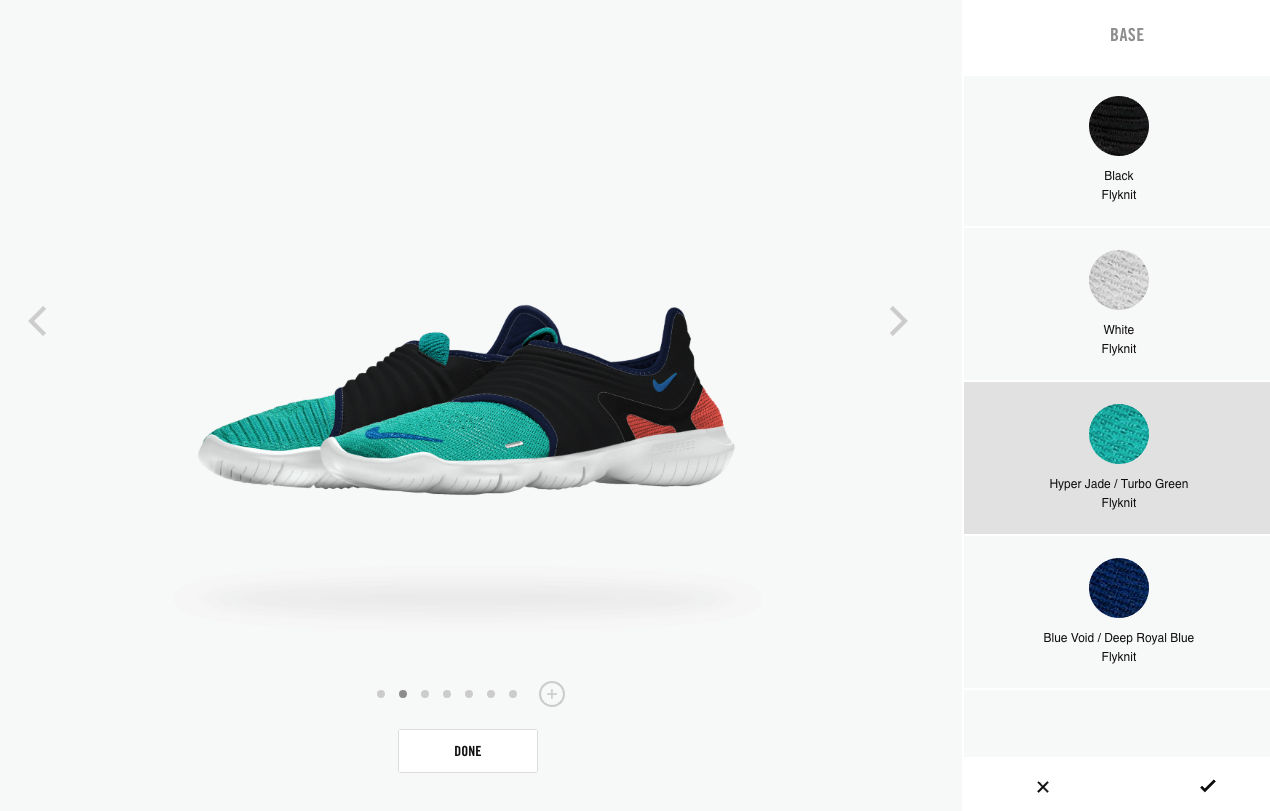 Author / Copyright holder: Nike, Inc. Copyright terms and license: All Rights Reserved. Used without permission under the Fair Use Doctrine (as permission could not be obtained).
Author / Copyright holder: Nike, Inc. Copyright terms and license: All Rights Reserved. Used without permission under the Fair Use Doctrine (as permission could not be obtained).
Figure 2. This online service from Nike allows customers to design their own shoes, taking self-service to a whole new level. This step towards personalization complicates the boundary between customers and industrial designers.
Traditional, front-line service employees have also been replaced by gig-economy workers. This phenomenon has come about due to smartphones, fast and ubiquitous networks, and advances in data science (Figure 3). The service innovation is both technical and economic. Service designers need to think of both as design materials in order to envision new innovations and new ways of living.
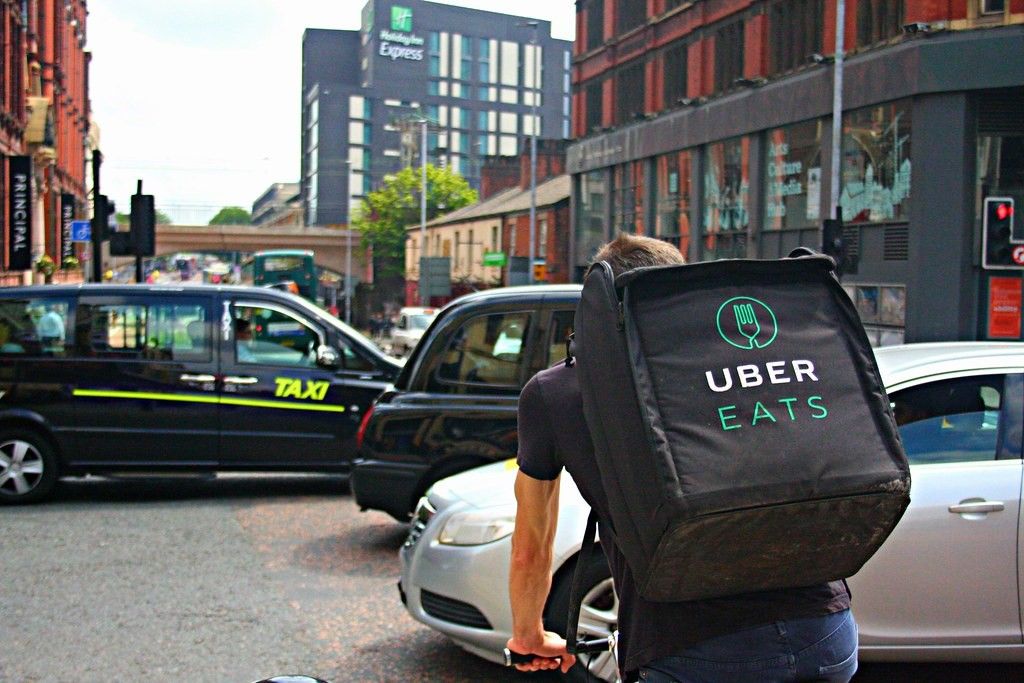 Author / Copyright holder: Courtesy of shopblocks. Copyright terms and license: CC BY 2.0 (Creative Commons Attribution 2.0 Generic)
Author / Copyright holder: Courtesy of shopblocks. Copyright terms and license: CC BY 2.0 (Creative Commons Attribution 2.0 Generic)
Figure 3. Gig-economy worker delivering food for Uber.
Services and Service Design
Services are different from products. Value functions as one of the most distinguishing features. When customers purchase a product, they give money and gain possession and ownership; they exchange money for a thing. When customers pay for a service, they get a performance. Someone does something they want. Service providers create value through their performance, but ownership does not transfer.
Starbucks provides a simple example. A cup of Starbucks coffee is a product. The customer pays for the coffee and then takes possession; they own the cup of coffee in their hand. The Starbucks store functions as a service. Frontline employees perform; they make and deliver the coffee on demand. The service generates revenue indirectly through the purchase of the beverage. At the end of a transaction, the customer does not own the store; nor do they possess or own the frontline employees. Starbucks operates as a product-service system (Morelli, 2003). The product enhances the service, and the service enhances the product. They need each other.
Since the 1950s, services and the service sector has grown to dominate the economies of the industrialized world (Cox et al., 2013). Services grew in importance because they helped increase the pace of financial transactions; they leverage the elimination of time and place that digital technology provides; something products cannot do as easily (Normann, 2001). Normann refers to this as dematerialization and liquification. For example, as money has increasingly become dematerialized, it increases liquification; it reduces friction in financial transactions by removing barriers of time and place.
Dematerialization, a topic very familiar to HCI research and UX practice, makes business run faster. Services innovate by dematerializing and increasing liquification. They do this through a process of unbundling and rebundling. For example, a grocery store might integrate a bank branch within its physical space. This unbundles the bank as a separate location that customers visit and rebundles the grocery store as a place that allows both the purchase of groceries and banking transactions. Placing the bank within the store reduces the physical distance a customer must travel between these two entities, increasing their likelihood of choosing this one-stop store over the use of separate grocery stores and banks. Placing this in more of a digital context, systems like Square unbundle point-of-sale systems from bulky cash registers and rebundle every smartphone as a potential point-of-sale system (Figure 4).
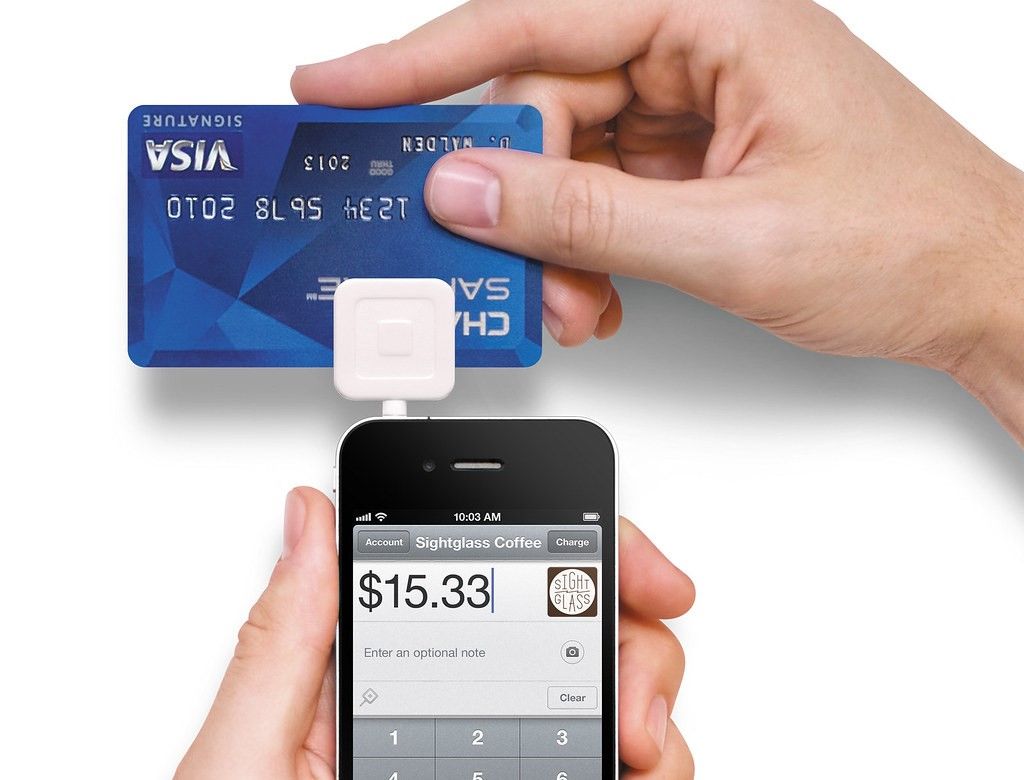 Author / Copyright holder: Courtesy of Rosenfeld Media. Copyright terms and license: CC BY 2.0 (Creative Commons Attribution 2.0 Generic)
Author / Copyright holder: Courtesy of Rosenfeld Media. Copyright terms and license: CC BY 2.0 (Creative Commons Attribution 2.0 Generic)
Figure 4. Square’s credit card reader came out in 2009. This Silicon Valley startup allowed any smartphone to become a cash register.
Service researchers link the rise of services to advances in ICTs (Normann, 2001). The HCI and UX design communities have played a significant role in advancing these technologies, in generating new product/service forms and in studying how advancing ICTs impact people’s lives. Yet, interestingly, both HCI and UX design tend to follow a product-centric design process. They focus on producing a thing. The underlying mental model still focuses on making things people want to possess and own.
At one time, both hardware and software employed a product-centric economic model. Microsoft’s Office suite of software provides a good example (Figure 5). At one time, customers could go to a store, select a box from a shelf containing the software and manuals, pay for this at a cash register and exit with their purchase in a bag. The customer would end up owning the physical materials and would have a license to install the software on a computer. This product-centric model worked for hardware (e.g., desktop computers, printers, consumer electronics) as well as software (e.g., operating systems, desktop publishing, databases).
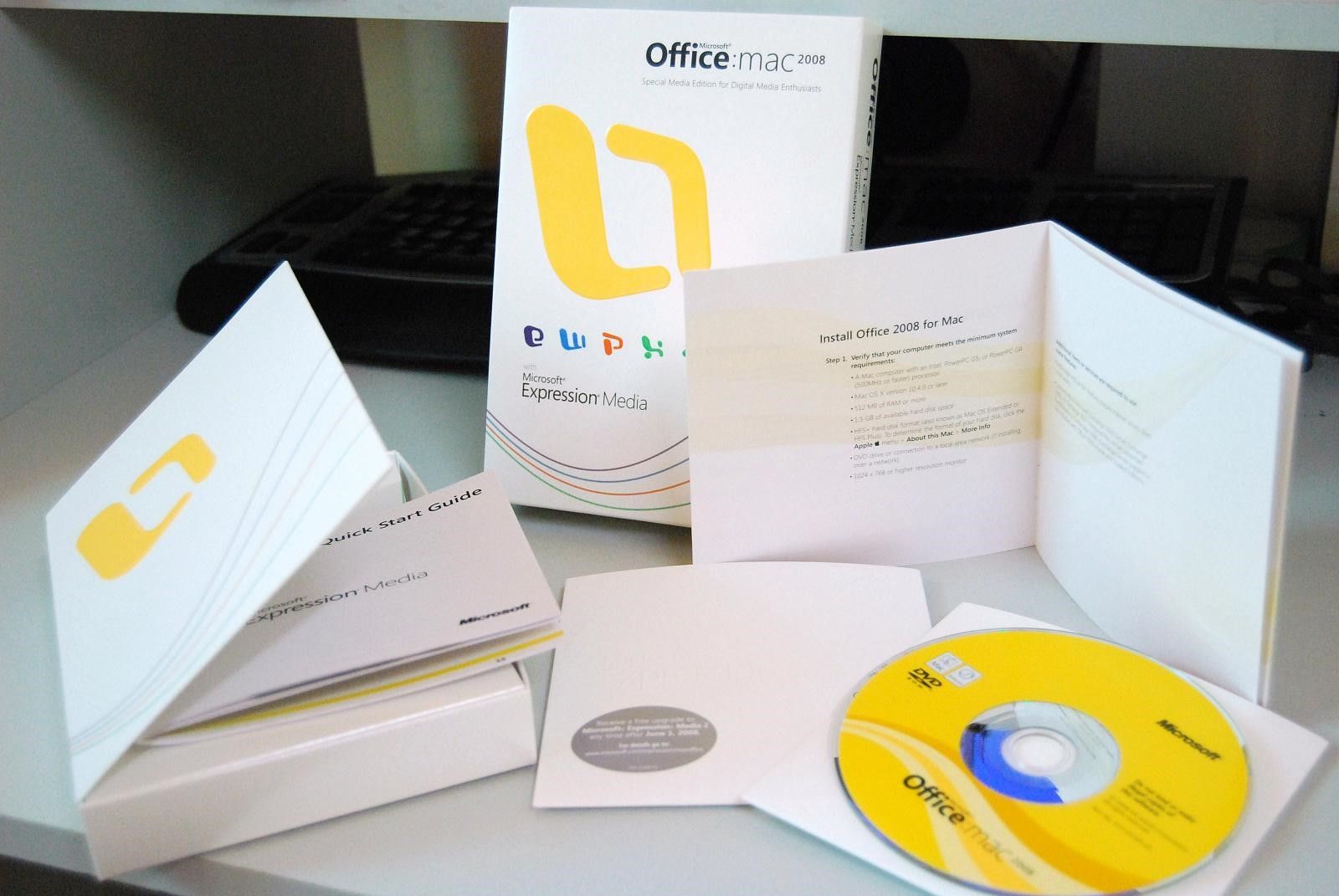 Author / Copyright holder: Courtesy of Long Zheng. Copyright terms and license: CC BY-SA 2.0 (Creative Commons Attribution-ShareAlike 2.0 Generic)
Author / Copyright holder: Courtesy of Long Zheng. Copyright terms and license: CC BY-SA 2.0 (Creative Commons Attribution-ShareAlike 2.0 Generic)
Figure 5. Microsoft Office, originally a product people selected off a shelf and paid for at a retail store. Customers owned the materials they purchased.
Two decades into the 21st century, many if not most hardware and software employ an economic model based on services. Google Docs provides an example (Figure 6). This online suite of software duplicates much of the functionality provided by Microsoft Office. However, there are several important differences and benefits of the service approach. Google Docs is free to use. Moreover, users never need to pay for an upgrade. Instead, every time they use these tools, they use the latest version, eliminating many problems caused when people attempt to collaborate while using different versions of a software product. Users never own the Google Doc applications. The fact that the service is free, without ownership, contradicts the implied role of user as paying customer that permeates user-centered design. Google Docs co-creates value between Google and users. Users get access to free software and Google get personal data based on how users engage with the software that they can sell to other companies.
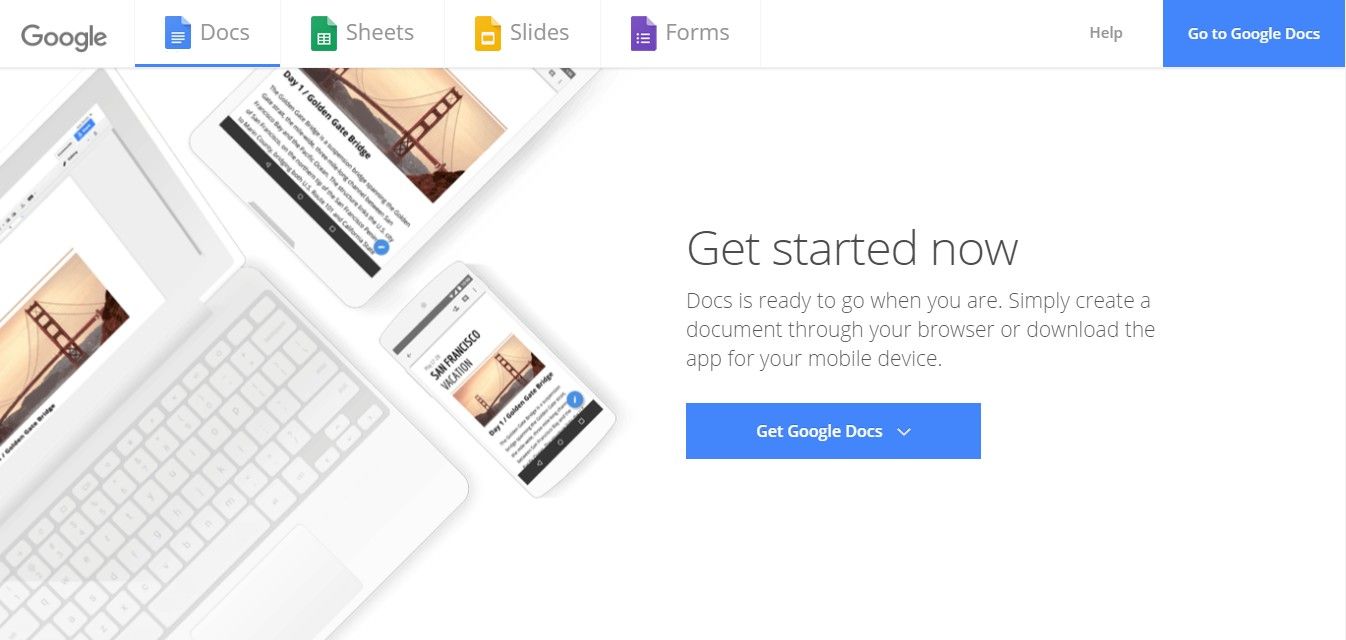 Author / Copyright holder:Google LLC ,www.google.com/docs/about. Copyright terms and license: All Rights Reserved. Used without permission under the Fair Use Doctrine (as permission could not be obtained).
Author / Copyright holder:Google LLC ,www.google.com/docs/about. Copyright terms and license: All Rights Reserved. Used without permission under the Fair Use Doctrine (as permission could not be obtained).
Figure 6. Google Docs offered access to productivity applications as a service, an alternative to Microsoft’s Office. While Docs was originally released as a free service to individual users, Google now charges enterprise customers for a version of Docs and keeps all information private, within the enterprise.
One complicating factor is that the ownership of the documents produced with these tools remains ambiguous. Users “own” the documents, but they do not have complete control, particularly when it comes to deleting. Comparing Google Docs to Microsoft Office illustrates the concept of disruptive innovation, a common type of advance in services. When engaged in disruptive innovation, service providers offer a much less expensive alternative to a product or service offering. The new version has only some of the features of the current market leaders, and the lower price point attracts customers away from the market leaders (Christensen and Raynor, 2003).
Today, the systems HCI and UX develop, innovate, and study function as product-service systems — systems that consist of human actors, technology touchpoints, environments, and other infrastructures that offer a holistic experience of use. Teams can innovate through productization, the creation of new products within a service. For example, Amazon’s Alexa is a product that customers can buy and own. It offers a new way to access Amazon’s services, such as Prime Music, as well as a variety of other services. Teams can also innovate through servitization, the creation of new services that surround products. For example, Apple’s iCloud service was added to and enhancing their many iOS and Macintosh products.
Key concepts from service design
Service design offers several key concepts that influence design thinking and make designing services considerably different from designing products. Many of these are particularly relevant to HCI research and UX design practice.
44.1 Service Concept
A service design process results in a “service concept” (Goldstein et al., 2002) (Figure 7). This includes four distinct elements:
Customers’ needs and desires
Service organization’s strategic intention,
Benefits customers receive (referred to as the what)
Description of how the service should be delivered (referred to as the how)
A well-designed service concept should reduce any gap between a customer or stakeholder’s expectations and the service that gets delivered. A well-communicated service concept should create an alignment between customers, stakeholders and service providers. Once created, a service concept can be used to help envision new services, to refine the details of an emerging set of service offerings and to guide deployment and assessment of new offerings. When creating a service concept, a service design team will also develop a strategy for operationalizing this concept and transitioning a service organization from its current state to this preferred future state. Once it has been completed, independent innovation teams can use it as a guide to develop many new offerings that will have less of a chance of conflicting with each other.
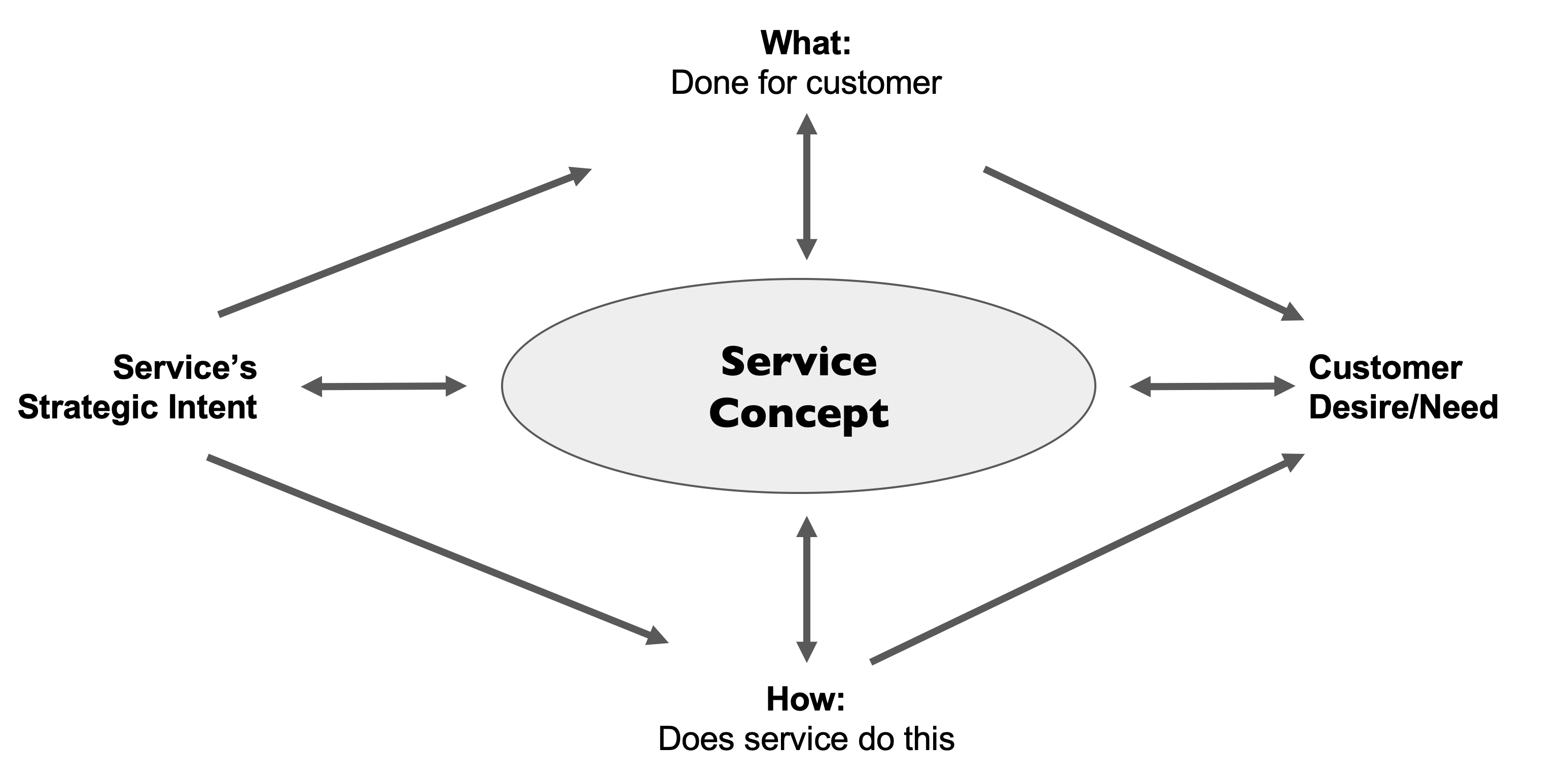
Figure 7. The service concept, adapted from Goldstein et al., 2002
44.2 Co-creation of Value
Service design distinguishes itself from product design through the idea that gets co-created between a customer and a service provider (Prahalad and Ramaswamy, 2004; Payne et al., 2008). For it to work effectively, customers must perceive that they will gain value by engaging with a service, and a service provider must perceive they will gain value by offering customers a service. Both sides must feel they are gaining more value than they are giving. Using Starbucks as an example, customers co-create value by selecting and then visiting a Starbucks to order a coffee. The service co-creates value by delivering a product their customers want and by selecting convenient hours and locations.
The peer-economy service Waze provides a nice example of this in a more digital space (Figure 8). Waze provides auto drivers with a free turn-by-turn navigation system enhanced with traffic details and other information. When drivers use the system, Waze collects location, direction and speed information. By aggregating the data from current users, Waze builds a detailed model of current traffic conditions. To collect data on roads less frequently travelled, Waze uses gamification, providing badges when someone drives out of their way to generate this more valuable data. In addition, the app allows users to add their own landmarks and descriptions of situations they encounter. Waze sells the traffic information to other interested stakeholders, generating the revenue that pays for software development and maintenance. Customers co-create value by generating the data Waze uses for the service and sells to others. Waze co-creates value by offering updated turn-by-turn navigation for free.
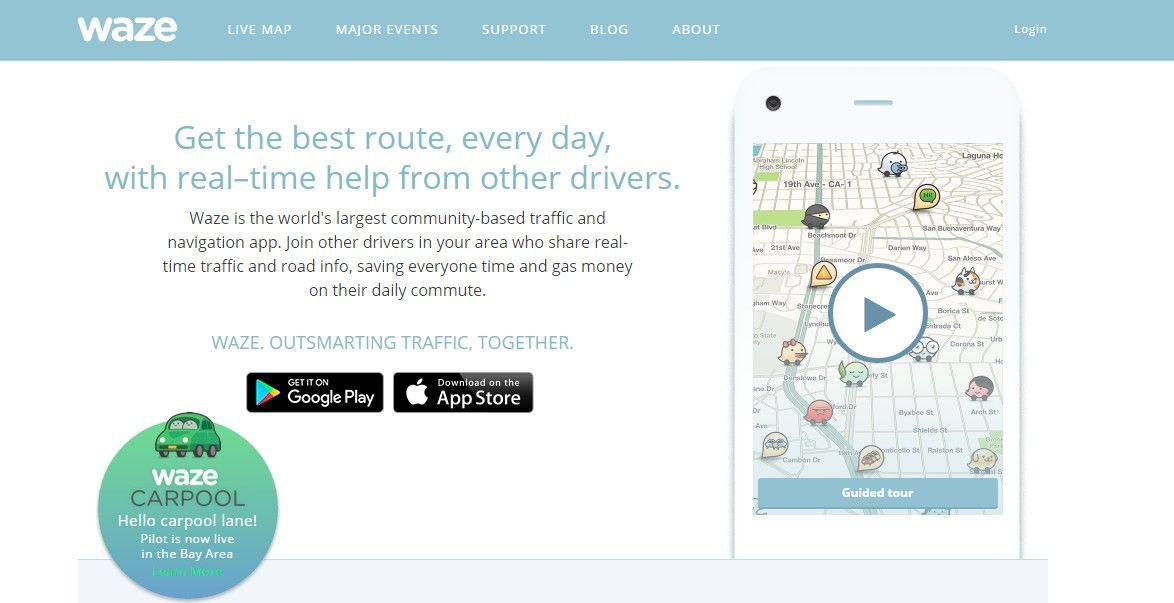 Author / Copyright holder: Waze. Copyright terms and license: All Rights Reserved. Used without permission under the Fair Use Doctrine (as permission could not be obtained).
Author / Copyright holder: Waze. Copyright terms and license: All Rights Reserved. Used without permission under the Fair Use Doctrine (as permission could not be obtained).
Figure 8. Waze is a mobile app that crowdsources traffic information. The service co-creates value with their customers.
Co-creation of value involves revenue as well as other forms of value. While UX design focuses almost exclusively on the needs of users, service designers look across a range of stakeholders, including the primary customer and service provider. They use this concept of value co-creation to envision a new ecology of value exchanged across and among all the stakeholders. The work is more systemic. Service designers work to identify the many different kinds of value each stakeholder wants, and they look at which interactions produce something that might be of value to a stakeholder. The growth of free mobile apps and online services drives service designers to search for revenue sources from stakeholders outside of the user-to-service-provider interactions. This challenge has become increasingly important for HCI researchers and UX designers. One challenge for UX design teams is that these efforts to co-create value for stakeholders often force teams to consider value well outside of people’s interactions with computers, and thus can feel well outside the domains of HCI and UX.
The service design literature often uses co-production of value and co-creation of value synonymously. Early work on service dominant logic used the term “co-production”; however, Lusch and Vargo switched to using “co-creation” due to a critique that the term co-production felt too close to producing products, the very mindset their service-dominant logic intends to overcome (2006).
44.3 Customer Competence
Customer competence is the recognition that customers can perform valuable aspects of a service (Prahalad and Ramaswamy, 2000). Service designers’ use of this concept often results in self-service innovations. One classic service design example is the recognition that customers can select their own groceries and the transition from general stores, where a clerk collected all of the items, to modern grocery stores where customers place the items that they want into a shopping cart or basket. The addition of a dial to early telephones represents another, more technically focused, recognition of customer competence; in this case, that customers could remember and dial a person’s phone number, reducing the need for an operator to connect each call.
When engaged in a design project, instead of only considering what a service might do for a customer or user, design teams also consider what customers can do for themselves and what they can do that is valuable for a service provider. Software companies’ use of users as beta-testers offers a great example. Companies recognized that some of their users have the skills needed to work with unfinished software and to recognize and describe software bugs. In this way, customer competence functions as an aspect of value co-creation. In the beta-testing case, companies get free labor to improve the software while select customers get a preview of what is coming and an opportunity to influence the final design.
Yelp provides an example of customer competence much closer to HCI and UX (www.yelp.com). For many years, HCI and UbiComp researchers prototyped location-based information services. An insurmountable problem these researchers never solved was how to populate systems with needed location-based information. Yelp solved this challenge by getting users to generate the information that these same users wanted. Yelp’s primary function allows users to rate and review local restaurants and other services. These online restaurant reviews have been so impactful that they have impacted more traditional forms of reputation (Luca, 2011). Customer ratings that result in a one-star increase for a restaurant can trigger a 5–9% increase in the restaurant’s revenue. In this example, Yelp provides a platform where users generate the data that users want.
44.4 Service Encounters and Touchpoints
Early research on service design and innovation investigated service encounters, the face-to-face interactions between customers and frontline employees (Bitner et al., 1990). This work detailed how employees could significantly improve a customer’s experience by recognizing and meeting their needs, by anticipating and exceeding their needs and by recovering from service breakdowns. As ICTs advanced and more and more frontline employees were replaced with computational systems, the meaning of a service encounter expanded to include both customer interactions with frontline employees and customer interactions with computer systems.
In developing service design methods, practitioners and researchers began to talk about touchpoints. These include every point of interaction a customer has with a service provider during the completion of a task or of a customer journey. Touchpoints include service encounters, but they also include other interactions a customer might have, including trying to park, navigating doors, signage and wayfinding, napkin dispensers and seating. When working to innovate a customer’s experience, service designers work to identify all the touchpoints across a customer’s journey and then search for more efficient ways to produce these or for ways to enhance or eliminate touchpoints.
44.5 Service Patterns
With the rise of the Internet, cloud computing and the Internet of Things, today’s services often rely on data streams and outcomes generated by other services. Services may be grouped together in a number of ways (Chai et al., 2005). One simple example is the now-common procedure of creating an account with a new service and authenticating the user’s identity using Google or Facebook credentials. The service design community has identified several service patterns. These include bundling and extraction, or grouping and ungrouping sets of services. Authenticating an identity using Facebook or Google credentials is an example of bundling.
The online travel planning service Kayak offers another example. They link information about hotels and airlines within a single planning tool. They are dependent on the information that other services provide to offer their own service. Uber passengers can access their Spotify playlist while in an Uber, but it is not necessary to do so as part of a ride. Passengers can check in for a flight using a generic kiosk at many airports, but the check-in service is not dependent on the airline’s business services.
Services can be scaled in time or area of coverage. A microservice is one used for short periods or in a local setting – for example, a service to wrap Christmas presents or a local service to report problems within a neighborhood. A macroservice, on the other hand, is used globally and for longer periods. For example, Google search is used by billions of people worldwide, every day.
44.6 The Customer’s Customer
Service delivery often involves a cascading and interoperating set of people who play the role of both customer and service provider. In these cases, the customer’s customer is the next person in a chain who will be served when the current customer transitions to the role of a service provider. Getting medication at a pharmacy is a simple example. The pharmacist is a customer of an online ordering system, using this system to receive notifications of new orders. In this case, the person receiving the medication is the pharmacist’s customer. A well-conceived service design focuses on the needs of the customer’s customer to increase co-creation of value. In UX design, the user is generally considered to be the customer; however, the UX design field often pays less attention to the needs of customer’s customer (Holmlid, 2009).
Service design process
A user-centered design process maps the current state of the world and envisions preferred future states in the form of new computational artifacts. Service design relies on a similar process with some important differences. Most importantly, a service design process results in a system, a service concept and a strategy for transitioning from the current system to the preferred system. Unlike UCD and UX, which focus almost exclusively on the user, service designers discover solutions at the intersection of the service provider’s and customer’s needs. As a result, a service design gets expressed through a series of models that serve as a description of what a service is, how it meets the needs of customers and how it fulfills the goals and initiatives of multiple stakeholders (Goldstein et al., 2002).
Three models commonly used to map the current state and investigate a preferred future for service design are a stakeholder model, a customer journey map and a service blueprint. A stakeholder model details the total set of relationships, generally from the perspective of a single stakeholder within the service system. A service blueprint maps a customer’s trajectory through a service, often to complete a task, such as buying a home (Bitner et al., 2008). It reveals the sequence of interactions the customer experiences across a collective set of touchpoints and then documents the elements and resources the customer interacts with and also the backstage business resources that must coordinate to provide the service. A customer journey map also maps a trajectory through a service, but with a focus on the customer’s motivations, experiences and emotions (Samadzadeh, 2015). The goal with all of these models is to represent elements in a way that rearrangement or alteration reveals changes to the whole system (Sevaldson, 2011). Products, services, people and relationships are represented in totality.
Service design models and plans become the basis for coordination of a service design team. Models are used to keep all team members in agreement, to develop scenarios and concepts and to consider implications of new products, services and systems that are introduced into the service ecology. They support a solution that is developed iteratively and holistically, evaluated and refined over time and put forth in the world with confidence.
In many ways, service design and design practice in HCI are quite similar. Both start with background research to understand the current state and to identify the needs of customers and users. Service deviates a bit in that it also works to identify the strategic initiatives of the service providers. UCD, UX and service all involve prototyping. With service, this often includes construction or simulation of specific environments where customers and service providers interact with each other. One key difference here is that service designers often develop the scripts used by human service providers. Service design teams create the tools and technology being used and the workflow supporting the service. HCI work, in contrast, generally only addresses the computational device and the interface used by the customers and the service providers. HCI and UX generally do not design scripts detailing how people should carry out their work.
To reduce the risk of deploying services that fail both in terms of the desired customer experience and the service provider’s ability to perform a service, service design teams will prototype their service design, iteratively improving the design in order to reduce or eliminate risks. When prototyping, design teams assess and refine their designs focusing on how customers understand the service solution, how the design fulfills a customer need and how the service creates value for both the customer and the provider (Polaine, Løvlie and Reason, 2013). Service prototyping often starts with needs validation, where initial service concepts are evaluated by framing them around a customer’s expressed or latent needs. It then takes the form of iterative prototypes, where more and more detail is added to understand how the service unfolds in a physical and social context, and what resources and touchpoints are needed to deliver it. Often, an experience prototype or user enactment—a built-out prototype with the goal of sampling social interaction around the service—is used to assess a proposed service (Bucheneau and Fulton Suri, 2000; Odom et al., 2012).
Comparing Service Design and UX Design
Service design and UX design share a focus on customer/user experience. However, service design’s explicitly systemic approach encourages a more holistic view of the problem space, considers a broader set of stakeholders and addresses a solution space that goes well beyond interaction with a digital system. Service designers work to develop a service concept as well as a strategy for orchestrating the strategy. By contrast, UX designers focus on prototyping a new or enhanced computational system.
UX designers bring a strong technology orientation to their design work. They like to push the boundaries of what is possible. Service designers, by contrast, seem to be more conservative when selecting which technologies to use. They bring a strong business orientation to their work, and they typically choose technology based on the business case. In practice, UX design focuses only on points where people implicitly or explicitly engage with computational technology. Service design has no such technology boundary. Service design practice considers all the touchpoints of the many different stakeholders that make up the ecology surrounding a service.
The analysis-synthesis bridge model (Figure 9) provides a nice framework for discussing UX and service design. It divides the design process into four quadrants (Dubberly et al., 2008). Both design practices begin by collecting data that documents the current state of the world. This includes fieldwork investigating user/customer practices as well as analytic investigations of computer logs detailing traces of user/customer behaviors. Methods used by both practices at this stage include interviews, observations, contextual inquiries (Beyer and Holtzblatt, 1997), directed storytelling (Evenson, 2006), focus groups, surveys and retrospective log analysis (Dumais et al., 2014).
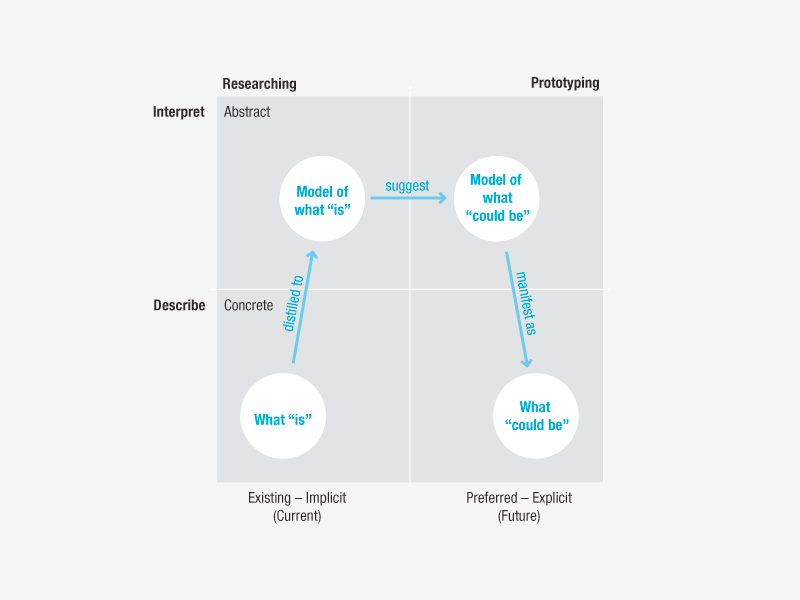
Author / Copyright holder: Hugh Dubberly. Copyright terms and license: All Rights Reserved. Reproduced with permission.
Figure 9. Analysis-synthesis bridge model.
Both practices involve synthesizing collected data by developing abstract models that describe the current state of the world and that point to opportunities to improve experience. Both entail the use of affinity diagrams (Hanington and Martin, 2012) involving hundreds of sticky notes. Design teams cluster items based on their affinity in order to identify important themes. Both involve the generation of conceptual models using conventional forms, such as quadrant plots, and they both also entail the creation of entirely new forms for conceptual models to reveal important relationships within the data (Johnson and Henderson, 2002; Mendel, 2012). Both entail the use of flow diagrams (Beyer and Holtzblatt, 1997) that detail communication patterns and breakdowns across roles and tasks, and the use of cultural models (Beyer and Holtzblatt, 1997) that show influencers and influencees, revealing problems and opportunities within the power dynamics. Both also involve the use of stakeholder maps (Hanington and Martin, 2012) that capture the relationships linking many entities within a system. Service designers almost always use customer journey maps (Nenonen et al., 2008) and service blueprints (Bitner et al. 2008) to better understand how all the elements of the service connect from a customer’s perspective. UX design teams increasingly use these two synthesis methods. Interaction design agencies such as IDEO promote their use of these methods (Richardson, 2010), and Cooper even provides detailed instructions for UX designers (Samadzadeh, 2015), providing details on when and how UX designers might use these methods.
Both practices involve a variety of methods to reframe the current situation, to set a goal for a preferred future and to envision new products and new service offerings that attempt to achieve this goal. They feature the use of modeling approaches such as product/service roadmaps or conceptual models that show a future system (Mendel, 2012). They both entail the use of personas to envision future users/customers along with their goals (Cooper, 1999). They involve the creation of mood boards to tease out possible emotional connections between users/customers and the future products and services. They also feature the use of brainstorming and bodystorming to ideate many possible futures. They also both involve sketching with narrative, using storytelling as a way to address the temporal aspects of an interaction design and of a service performance.
Once a direction and goal have been selected, a team uses both to employ rapid prototyping; the team iteratively develops and evaluates a design idea to reduce the risk of making products and services that fail at launch. Prototyping in UX generally calls for a focus on usability, but it also includes testing performance of new technology and assessment of user experience. Prototyping a service can often be more complex, expensive and time-consuming, as designs often involve new physical environments and new employee performances. Evaluation continues as the product or service transitions from prototyping to launch. At this stage, teams specify measures to track the uptake of a new design and will often employ A/B testing to make iterative changes to a released system in order to continually improve customer and user experience. For an interactive system, this is often the release of multiple controlled versions of the same software system. For services, this might include test launches of new offerings in specific regions.
An important distinction between these two practices revolves around the output of the design process. In UX design, the main deliverable most often involves a working prototype that demonstrates the technology and communicates the intended user experience. In service design, the main deliverable most often takes the form of a service concept and a strategy by which a service organization can co-create value between the service and its customers. This is usually accompanied by a suite of artifacts that demonstrate different embodiments of the service concept as well as a strategy that ties them together. The service concept provides a unified vision that helps drive decision-making and innovation across the service organization, allowing the design work to proceed well beyond the scope of an individual team. As UX designers work, they give form to the behavior of interactive systems by imagining this behavior and imagining users’ reactions to this behavior. As service designers work, they give form to the performance of a service by imagining customers and service agents interacting across touchpoints. In both practices, designers spend much of their time imagining and assessing how users might react to system behaviors and how customers react to service performances.
Technology Orientation versus Business Orientation
UX design practice has an inherently strong technology orientation. Design teams specifically investigate opportunities for emerging technology to meet or exceed users’ needs and desires. Major design themes within the UX community revolve around technology pillars such as big data, the Internet of Things, wearables, quantified self, AI as the new UX, crowd computing and social computing. Even more socially and societally oriented themes within UX design such as HCI4D (for the developing world) and Sustainable UX involve the investigation of how current and emerging technology can be employed to impact these large-scale problems. The invention of new technology remains a core value and driver of HCI research and UX design practice.
In service design, by contrast, one finds a more conservative approach to the use of technology. Service design has a strong business orientation that requires clearer justifications for taking technology risks. Design teams investigate the flow of value between different stakeholders across the service ecology. Designers discuss and play with different value propositions that can motivate the behaviors they want. While most UX design processes rarely consider payment as a motivating force, the design of an underlying economic model remains core to service design. Service designers view current and emerging technology as a disruptive force. They do not invent new technology. However, they look for new ways to deploy known technologies and new ways these systems can become services that disrupt the flow of value. They view technology as an opportunity to reduce service delivery costs through the creation of self-service offerings, and also as a risk, as they note how interactions with technology during service encounters can disrupt rapport building between customers and frontline employees (Giebelhausen et al., 2014).
While UX design looks to invent new technology that can improve people’s lives, service design looks to invent new business models that improve value co-creation for customers and services. Professionals working in both fields are very creative in their investigations, but they look for solutions in different places. Concepts such as freemium or in-app-purchase would more likely emerge from a service design process than a UX process. Ideas such as automatically tagging friends in photos posted to social media or text autocorrection on mobile devices would more likely result from a UX design process than a service design process.
This difference in orientations likely comes from the origins of UX and service design. UX comes from HCI, which started as a collaboration between computer science and psychology. Service, on the other hand, started as a collaboration between marketing and operations within business schools. While both design practices have grown to integrate many other disciplinary perspectives, the orientations from their distinct origins remain.
Overlaps and Boundaries of Practices
Due to both technology advances and the innovation of economic models, service design and UX design projects increasingly overlap. Nevertheless, differences in the boundaries of each practice make it easy to distinguish them.
One major cause of an overlap between service design and UX design comes from the increasing use of technology in service environments. Early examples include point-of-sale systems that tracked purchases, updated inventory, retrieved previous orders or reservations or allowed for ordering items not in stock. Next came a wave of self-service systems that often replaced frontline service employees including automatic teller machines, self-service gasoline pumps, airline check-in kiosks and transit ticket vending machines. In some cases, self-service systems were integrated into a larger service redesign projects with little concern for the UX design. Norman famously uses the frustrating and confusing transit ticket vending machines as an example of a self-service system placed into a service environment with little UX consideration (Norman, 1988). While the economic aspects and the user desire for efficiency of a self-service system might have been well considered, the UX aspects failed.
Another area of overlap began when traditional brick-and-mortar services began offering websites that allowed customers to complete a variety of transactions. Examples include retail stores and online ordering, hotels and online reservations, airlines and online ticketing, government agencies allowing access to information or applications for licenses or permits. Initially these were mainly executed as UX projects that often functioned very independently from the frontline employee side of the service. Recently, however, projects have grown considerably more integrated across service and UX as the volume of online interactions and the complexity of these interactions have continued to skyrocket. Companies often had a digital strategy distinct from their overall strategy and even digital design teams that worked independently from the other service design activities.
By the close of the 2010s, the landscape had become even more blurred. The rapid adoption of smartphones and recent development of apps meant to enhance customers’ in-store experiences, as well as the increasing use of kiosks within traditional brick-and-mortar services, drove many service and UX designers to work together. Moreover, the phenomenon would witness the transitioning of many UX designers into UX service designers. Starbucks’ mobile app provides a nice example of the kinds of in-store services companies offer including loyalty programs, product descriptions, promotions and remote ordering with in-store pickup (Figure 10). The app even provides the name of the song currently playing in the store. These examples of increasing overlap have mostly been driven by the increasing capabilities of new technology to increase a customer’s utility while reducing overall costs, such as replacing an employee with a kiosk, website or app. Many companies now embraced the concept of omni-channel service delivery, the idea that customers want and expect to be able to complete any part of a transaction using any and all channels a service offers including in-store, phone, web and mobile app (Brynjolfsson et al., 2013).
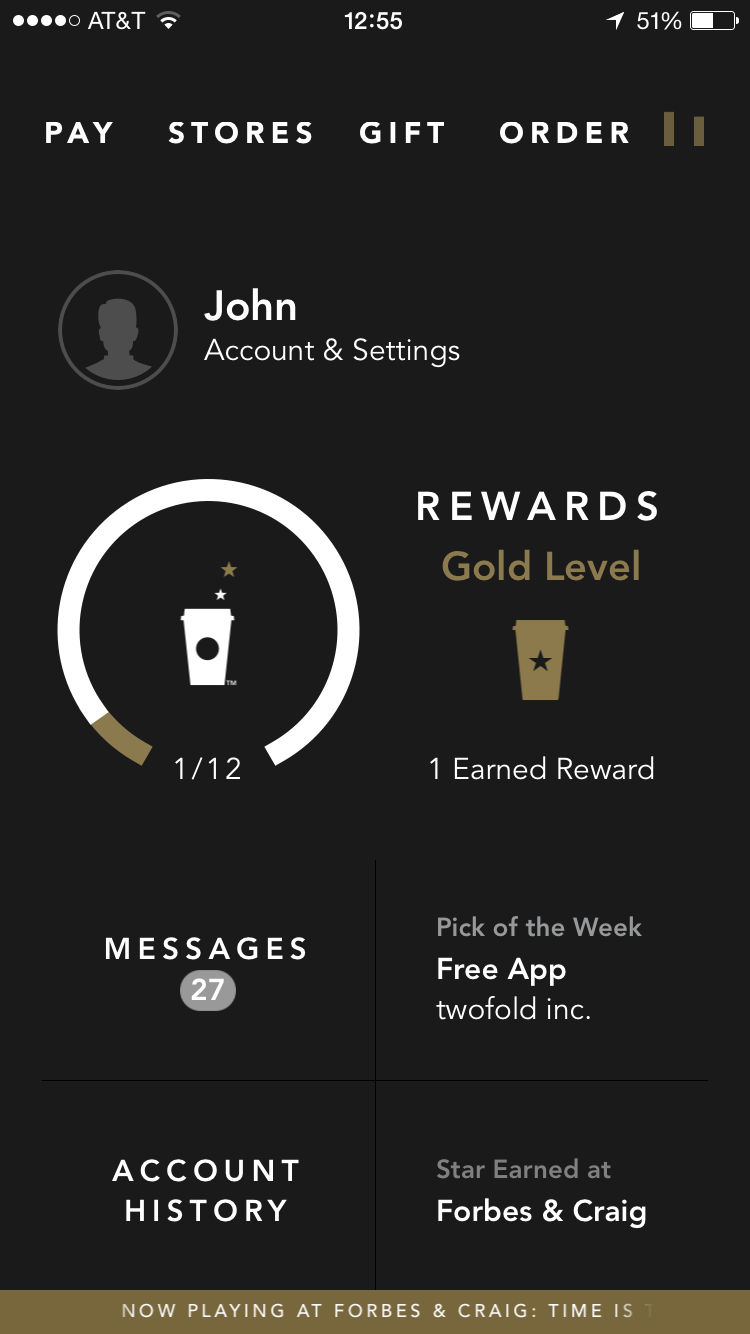
Author / Copyright holder: Starbucks Coffee Company. Copyright terms and license: All Rights Reserved. Used without permission under the Fair Use Doctrine (as permission could not be obtained).
Figure 10. Starbucks app with in-store features such as payment, redemption of loyalty rewards and even the name of the song currently playing.
Peer-economy services are another example of the increasing overlap between service design and UX design. For the peer economy, both innovations in technology (increasing ubiquity of smartphones and increase in mobile network speeds) and innovations in economic models (models that disrupt traditional services) play an equal role. Peer services—such as KickStarter (crowdfunding for projects from products to movies challenges traditional use of banks and investors); Airbnb (people renting rooms to travelers challenges traditional use of hotels); Uber (people offering car rides for money, challenges traditional use of taxis); and Mechanical Turk (crowdsourcing whereindividuals complete distributed microtasks, which challenges the traditional hiring of employees)—all challenge traditional service models. These services thrive and fail based on the quality of the user experience and on the ability of the underlying economic model to produce value. Unlike many UX projects that focus on the experience of a single consumer, these services challenge design teams to envision an effective ecology of exchange between two different stakeholders while also producing value for the service provider that brings these stakeholders together. These services only work when the UX and service design work effectively together.
While UX design and service design increasingly overlap, one can easily identify the two practices by the boundaries they place at the edge of their practices. Most UX designers and UX projects bind themselves to interactions that happen with a computational system. While design teams consider many factors outside of this interaction, what they actually design is the behavior of the computational system, thus creating this boundary. Service designers do not follow any technology boundary and instead bound their work by the edge of the specific service they are working on. Using Starbucks as an example again, a UX design team would design the behaviors for the company's website, mobile app and point-of-sale system used by the frontline employees. Service designers would additionally design work routines of the frontline employees, such as writing a customer’s name on a cup, translating the customer order into a consistent language that can be marked by the order-taking employee so that the barista makes the correct beverage. While UX teams design the tools workers use, they have no history of designing how employees are expected to perform the work. Service designers also consider the design of the store environment as well as the placement of the store in various locations, such as airports, hotels and strip malls. This work falls well outside of the scope of UX design as it is currently practiced.
Opportunities for Service Thinking in UX Practice
UX design has functioned well as the standard of practice in the design of technology products and services for many years. The evolution within HCI from its narrow focus on usability and ease of use to the broader considerations of user experience has allowed for increasing influence within the technical development community. Nevertheless, there are three themes within current UX design work that would benefit from service thinking: Software as a Service, social computing and design for social change.
Software as a Service
Like other industries, the software industry has been changing its underlying economic model. It has been transitioning from software as a product to Software as a Service (SaaS). With this new model, customers most often subscribe to the software they wish to use, paying a recurring monthly or annual fee. Many service models also use variable pricing based on how much a customer uses the software or the underlying resources associated with it. Designers familiar with Adobe software recently experienced the transition from a product model to a service model when Adobe began charging a monthly fee for access to their creative suite of software. SaaS has several benefits, including lower costs to begin using a service and the elimination of versioning problems that plagued software when sold as a product. It also generates enhanced analytics on customer behavior that benefits service providers.
Much, if not most, commercial software employs a SaaS model; thus, UX design teams are fundamentally always designing services and not products. This is particularly true for online tools/services that run in browsers and for mobile apps that sell for 99 cents or are often free. The rise of free online tools as well as the meteoric rise of smartphones and other mobile devices has accelerated the software industry’s transition to a service model. In addition, it complicates UX design, as the user of a free service or 99-cent app is almost never the customer; they are not paying the software development and maintenance costs. In most cases, the users function as a product that software companies sell to third parties.
In design practice, UX design teams need to consider the needs of these third parties, and they must either design interactions that capture the behaviors the third parties are interested in ordeliver the messages third parties wish users to receive. When designing in these situations, service designers focus on the co-creation of value between customers and service providers can help surface more appropriate design opportunities. Evidence that service thinking is becoming embedded in current UX practices includes the increasing use of terms such as “onboarding” – a business term traditionally used to describe the process by which new employees are trained in a company’s practices and culture (Bradt and Vonnegut, 2009). It is now commonly used by UX designers to describe interaction designs that allow users to create an account and begin using a new service (Hess, 2010).
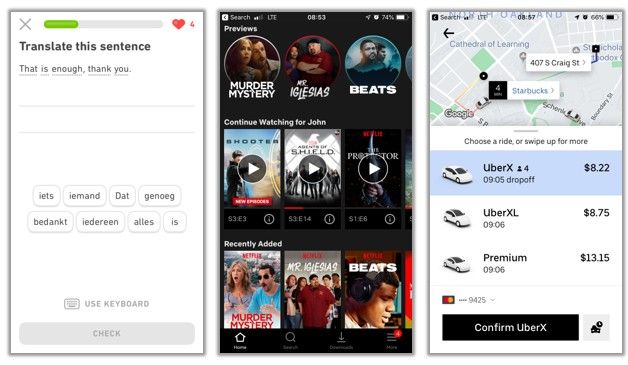
Author / Copyright holder: Duolingo, Netflix, Inc and Uber Technologies, Inc. Copyright terms and license: All Rights Reserved. Used without permission under the Fair Use Doctrine (as permission could not be obtained).
Figure 11. These three familiar mobile app services (DuoLingo, Netflix and Uber) use three different but common economic models. DuoLingo uses a freemium model; with a free service tier that has ads and a pay service tier that does not have ads. Netflix uses tiered, fixed pricing; customers pay a fixed monthly fee for different levels of service. Uber use a usage model; customers pay based on the amount of the service that they use.
Social Computing
Social computing has long been a research topic within HCI. The tremendous popularity of social media services such as Twitter, Facebook, Foursquare, Instagram and Snapchat, along with the rise of crowdpowered services ranging from Wikipedia (crowd curated encyclopedia) to Yelp (crowd reviews and ratings of services based on location) to Waze (crowd generated traffic and driving information) to Mechanical Turk (global crowd workplace), has made the design of social computing services a mainstream part of UX design practice.
UX designers working on social computing projects can benefit from service design’s systemic approach. Their work is really to envision a sustainable ecology of exchange among a set of stakeholders, in addition to the UX focus on meeting and exceeding the needs and desires of users. For example, Instagram requires content creators (celebrities, artists, families and friends making and sharing images), content consumers (those who view and like the images) and advertisers who wish to market products and services to the content consumers. Yelp requires a steady stream of users who want localized reviews of services, users willing to generate reviews of these services and service vendors who purchase ads on Yelp to promote their services. Effective UX design teams work to consider the needs and desires of all constituents in the ecology and develop web- and app-based interfaces that let them find information, share information or monitor the use of a service in order to tune it to be more effective.
Design for Social Change
In UX design education, research and practice, there has been an increasing interest on design for social change. Design teams increasingly use design thinking and advances in communication technologies to take on societal level issues including sustainability, public health and wellness, citizen participation in community improvement and challenges faced in the developing world. These projects often focus on how the disruptive power of new technology can generate new opportunities for people to improve their own lives. UX design has played a central role in this space due to its deep connection and inventive orientation to technology.
UX design teams working on these types of project can benefit from two aspects of service design. For many—if not most—of these projects, the focus is much more on achieving a public good than on the needs and desires of individual users looking to make a consumptive choice. User needs are still critical, but one must place these within the context of the larger project goals. Service thinking can benefit UX teams because of the focus on co-creation of value across and between the many stakeholders involved. Moreover, with communication, technology can help address these large-scale challenges; in most cases, these systems can only have a limited impact if they are not integrated into other service offerings or integrated with policy changes. Service design’s ability to work beyond the boundaries of a person’s interaction with a technology system allows for a more holistic search for solutions.
Predicting the Future
Below, we speculate on how the relationship between UX/HCI and service design will continue to unfold interact. We discuss this in terms of design practice, design education and design research.
Future Design Practice
UX designers already often work like service designers, especially when they synthesize their data using service blueprints and customer journey maps. These tools force design teams to account for customer interactions with non-computational touchpoints across a service. They also enforce a systemic view of the interplay between a customer and a service. In this way, UX designers are and will continue to be practicing service design, even if they do not call themselves service designers and even if they don’t realize they are increasingly doing service design.
Over time, we expect that UX design will become a highly specialized sub-discipline of service design. We see this as being like the relationship between architecture and urban design, where urban design has become a highly specialized subdiscipline with a specific set of concerns and skills. In this speculation on future design practice, almost all projects will be service design projects, and when teams begin to sketch and prototype the behavior of interactive computational systems, they will draw on team members who have deep experience in UX practice to lead and guide the design decisions.
Future Design Education
UX design has experienced a huge growth in design education. Since the 1990s, many new master programs in interaction design have started. More recently, undergraduate programs have started to offer degrees in UX design, and many online education and training services have started offering courses and certificates in UX design. This growth seems largely driven by industry demand for workers with these skills. Service design has also experienced growth since the 1990s, but it has been considerably slower. While there are hundreds of UX programs to choose from, there are closer to only 30 or so programs offering degrees in service design.
We predict this may change. If industry demand changes, and they begin to ask for service designers, we expect many programs will re-tool their UX programs to produce students cross-trained in both service design and UX design. Again, the methods and processes are actually quite similar. Furthermore, we suspect that business schools might step into this space and start offering service design degrees more strongly grounded in business processes. There are several new programs that mix design thinking and business happening at business schools or in departments outside of a school of design. In addition, business schools are increasingly offering training and courses on design thinking.
Future Design Research
Service design and UX design are both traveling towards the same future, largely driven by continued advances in technology and societal changes happening in relation to this technology. We see several research priorities that will increasingly matter to both communities. These include:
Big Data and AI: The collection and use of big data, coupled with continued advances in AI, raise a host of design research topics. These range from ethical issues around data privacy, transparency of services, algorithmic bias and the ethics of making certain kinds of inferences, such as the use of gender, race or social class to negatively characterize a group of people. In addition, there are more basic design research questions, such as how to design with data and how to engage AI as a design material in order to envision things not likely to be imagined by people with a Ph.D. in machine learning.
Social Design: Large-scale societal issues such as social justice and sustainability have become increasingly important to design research, and we expect this to continue. Technical advances will continue to provide both new solution paths and new unintended consequences, and we suspect design research in this area, that employs the systemic perspective found in service design, will continue to grow.
Global Design: With the growth of apps and online services, there is an increasing challenge to design at a global scale, to design products and services that function at a global scale; that respect local rules, cultural norms and conform to local laws, and that allow users to seamlessly navigate the world while accessing and using a familiar and personalized set of tools and services. We do not know how to design these kinds of things, and we expect this will begin to emerge as a new topic of design research that draws strengths from both UX design’s expertise in technology and service design’s systemic perspective and concern for a customer’s unfolding experience across a variety of touchpoints.
Where to learn more
There are many places to look to learn more about service design.
Andy Polaine, Lavrans Løvlie and Ben Reason have written a excellent book describing service design practice: Service Design. From Implementation to Practice (Polaine et al., 2013).
The Service Design Network is a great source for information and for meeting people working in service design. They produce an annual conference, hold events in cities around the world and publish Touchpoint, a journal devoted to the practice of service design.
The Journal of Service Research is a scholarly journal discussing research issues related to service research.
Service design and its relationship to UX and HCI is also a frequent topic of design articles published on Medium.
References
Beyer, H., & Holtzblatt, K. (1997). Contextual design: defining customer-centered systems. Elsevier.
Bitner, M. J., Booms, B. H., & Tetreault, M. S. (1990). The service encounter: diagnosing favorable and unfavorable incidents. The Journal of Marketing, 71-84.
Bitner, M. J., Ostrom, A. L., & Morgan, F. N. (2008). Service blueprinting: a practical technique for service innovation. California management review, 50(3), 66-94.
Bradt, G. B., & Vonnegut, M. (2009). Onboarding: How to get your new employees up to speed in half the time. John Wiley & Sons.
Buchenau, Marion, and Jane Fulton Suri. "Experience prototyping." In Proceedings of the 3rd conference on Designing interactive systems: processes, practices, methods, and techniques, pp. 424-433. ACM, 2000.
Brynjolfsson, Erik, Yu Jeffrey Hu, and Mohammad S. Rahman. Competing in the Age of Omnichannel Retailing. MIT, 2013.
Chai, K. H., Zhang, J., & Tan, K. C. (2005). A TRIZ-based method for new service design. Journal of Service Research, 8(1), 48-66.
Christensen, CM., Raynor, ME. The Innovator's Solution: Creating and Sustaining Successful Growth, Harvard Business School Press, Cambridge, MA, USA, 2003.
Cooper, A. (1999). The inmates are running the asylum:(Why high-tech products drive us crazy and how to restore the sanity) (Vol. 261). Indianapolis: Sams.
Cox, A., Duhigg, C., G.V. Xaquin, Grondahl, M., Park, H., Roberts, G, and Russell, K. (2013). The iPhone Economy: A Shift From Manufacturing. New York Times, http://www.nytimes.com/interactive/2012/01/20/business/the-iphone-economy.html?scp=51&sq=product+manufacture&st=nyt, accessed September 15, 2014.
Dubberly, H., & Evenson, S. (2008). On modeling: The Analysis-synthesis Bridge Model. Interactions, 15(2), 57-61.
Dumais, S., Jeffries, R., Russell, D. M., Tang, D., & Teevan, J. (2014). Understanding user behavior through log data and analysis. In Ways of Knowing in HCI (pp. 349-372). Springer New York.
Evenson, S. (2006). Directed storytelling: Interpreting experience for design. Design Studies—Theory and Research in Graphic Design, a Reader, 231-240.
Giebelhausen, Michael, Stacey G. Robinson, Nancy J. Sirianni, and Michael K. Brady. "Touch versus tech: When technology functions as a barrier or a benefit to service encounters." Journal of Marketing 78, no. 4 (2014): 113-124.
Goldstein, Susan Meyer, Robert Johnston, JoAnn Duffy, and Jay Rao. "The service concept: the missing link in service design research?" Journal of Operations management 20, no. 2 (2002): 121-134.
Hanington, B., & Martin, B. (2012). Universal methods of design: 100 ways to research complex problems, develop innovative ideas, and design effective solutions. Rockport Publishers.
Hess, W. (February 16, 2010). Onboarding: Designing Welcoming First Experiences: You don't get a second chance to make a first impression. UX Magazine. Article No: 487. https://uxmag.com/articles/onboarding-designing-welcoming-first-experiences
Holmlid, Stefan. "Interaction design and service design: Expanding a comparison of design disciplines." Proceedings of NORDES (2009).
Johnson, Jeff, and Austin Henderson. "Conceptual models: begin by designing what to design." Interactions, 9,1 (2002): 25-32.
Mendel, J. (2012). A taxonomy of models used in the design process. http://www.dubberly.com/articles/taxonomy-of-models.html
Luca, Michael. "Reviews, reputation, and revenue: The case of Yelp. com." (September 16, 2011). Harvard Business School NOM Unit Working Paper 12-016.
Lusch, Robert F., and Stephen L. Vargo. "Service-dominant logic: reactions, reflections and refinements." Marketing theory 6, no. 3 (2006): 281-288.
Morelli, Nicola. "Product-service systems, a perspective shift for designers: A case study: the design of a telecentre." Design Studies 24, no. 1 (2003): 73-99
Nenonen, S., Rasila, H., Junnonen, J. M., & Kärnä, S. (2008). Customer Journey–a method to investigate user experience. In Proceedings of the Euro FM Conference Manchester (pp. 54-63).
Norman, D. A. (1988). The psychology of everyday things. Basic books.
Normann, Richard. Reframing business: When the map changes the landscape. John Wiley & Sons, 2001.
Odom, William, John Zimmerman, Scott Davidoff, Jodi Forlizzi, Anind K. Dey, and Min Kyung Lee. "A fieldwork of the future with user enactments." In Proceedings of the Designing Interactive Systems Conference, pp. 338-347. ACM, 2012.
Payne, Adrian F., Kaj Storbacka, and Pennie Frow. "Managing the co-creation of value." Journal of the academy of marketing science 36, no. 1 (2008): 83-96.
Polaine, A., Løvlie, L., & Reason, B. (2013). Service design. From Implementation to Practice. New York: Reosenfeld Media.
Prahalad, Coimbatore K., and Venkatram Ramaswamy. "Co-opting customer competence." Harvard Business Review 78, no. 1 (2000): 79-90.
Prahalad, Coimbatore K., and Venkat Ramaswamy. "Co-creating unique value with customers." Strategy & leadership 32, no. 3 (2004): 4-9.
Richardson, Adam. 2010. “Using Customer Journey Maps to Improve Customer Experience.” Harvard Business Review. https://hbr.org/2010/11/using-customer-journey-maps-to
Samadzadeh, Shahrzad. 2015. “Customer Journey Map or Service Blueprint?” http://www.cooper.com/journal/2015/5/journey-map-or-service-blueprint
Sevaldson, B. (2011). “GIGA-Mapping: Visualisation for complexity and systems thinking in design.” Nordes, (4).
Vargo, Stephen L., and Robert F. Lusch. "Evolving to a new dominant logic for marketing." Journal of Marketing 68.1 (2004): 1-17.

